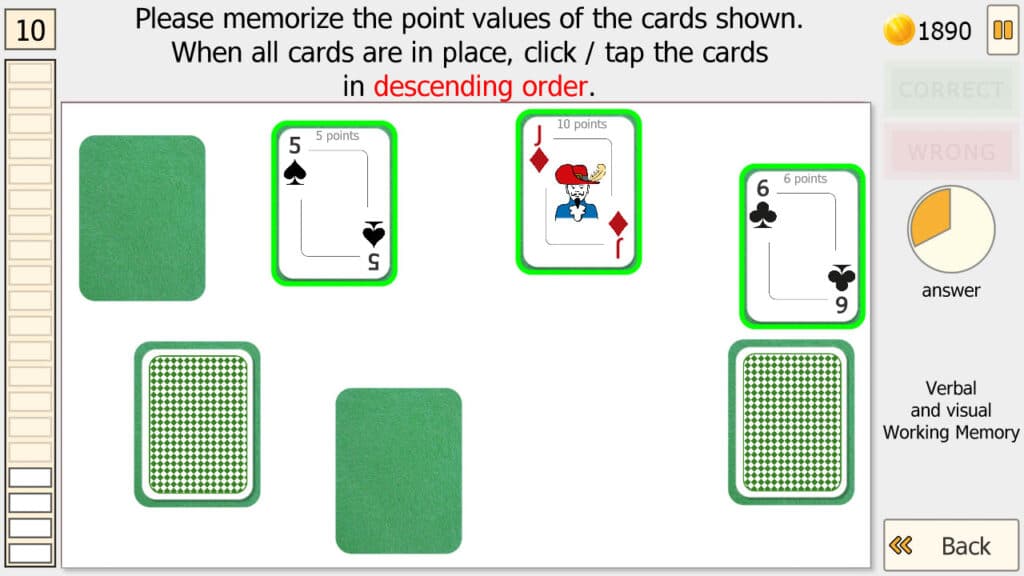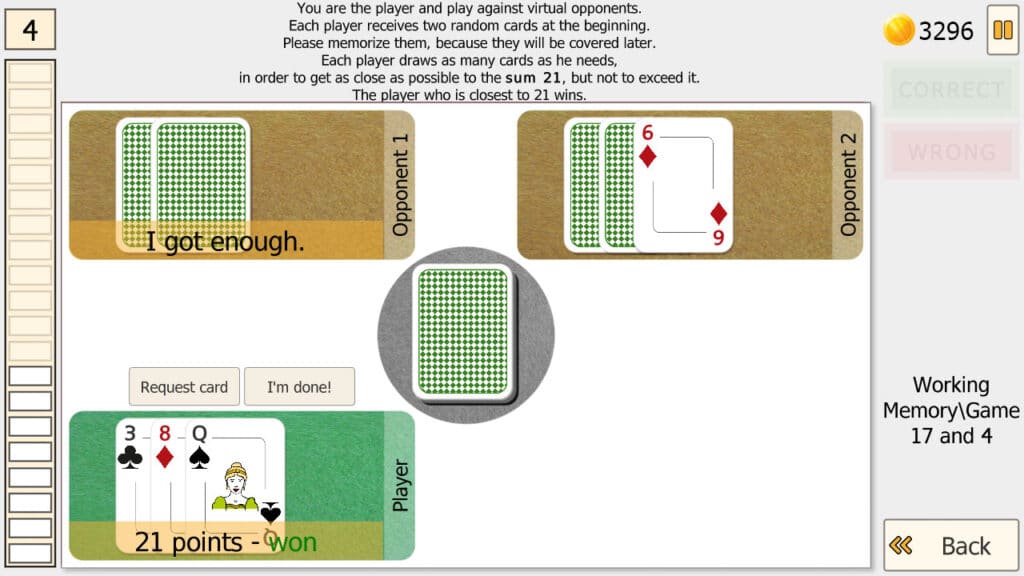
































































Training goal
The aim of working memory training is to improve the processing capacity of the brain and thus to optimize concentration, reasoning and learning.
What is working memory?
Working memory (WM) is the ability to keep information in consciousness. We use WM to pursue plans or to take relevant information into account when solving problems.
WM is closely related to the control of attention, and these skills use in part the same regions of the parietal and prefrontal cortex in the brain (Ikkai and Curtis, 2010; Constantinidis and Klingberg, 2016).
We use the WM to remind ourselves of what to focus on.
All individuals differ in their WM capacity. A low WM can be caused by environmental factors such as stress or by injuries to the brain. Many diagnoses and clinical conditions are associated with low WM and attention deficit, including ADHD, ADD, traumatic brain injury, premature birth, stroke, and cancer treatment.
The consequences of impaired WM are similar regardless of the cause: an inability to remember plans and instructions, or an inability to successfully complete everyday tasks. A high degree of distractibility of the individual is also often perceived, especially pronounced in mentally demanding situations.
In children, WM deficits result in school problems in reading and mathematics.
Theoretical foundations
Current theories about working memory come from A. Baddeley from: “Working Memory: Theories, Models, and Controversies“ (Annu. Rev. Psychol. 2012. 63:1–29).
It describes 5 components that represent working memory:
- The central executive,
- The episodic buffer,
- The visuospatial sketch pad,
- and the phonological loop with attached articulatory loop.
All components are activated when the user works with the present WM training.
The goals of the training are to practice typical WM content using a card game:
- n-Back: remembering card values,
- add up: calculation of sums of memorized card values,
- sort: sort cards from memory by size,
- Shift visually and spatially: assign memory content spatially and keep it up-to-date,
- hold and use: use and manipulate memory contents during strategic tasks.
Task description
At the beginning of the training, the user can select which sub-function of the working memory is to be trained.
The 5 sub-tasks are independent of each other and can be used regardless of the sequence.
Each sub-task provides a different number of levels of difficulty (53 in total) and automatically adapts to the performance of the trainee.
Settings
The module selection contains settings that affect all sub-modules.
Number of steps per level
The number of tasks that the user must successfully solve in a row, in order to get to the next higher difficulty, is set. One step is deducted for each error.
The higher the number of steps, the longer the user remains in a level and thus consolidates the success in exercising.
Limit training duration
The training can be carried out with or without a time limit. If users tend to be overwhelmed, it is suggested to limit the duration of the training. This setting is also useful in therapy settings in which the times are fixed.
Double acquisition time / double answer time
A memory task often consists of memorizing (acquisition) and querying (reproduction) of the information. In all of the subtasks there are different requirements for the trainee. Each sub-task also has a tried and tested and optimized scheme of which times are used in which degrees of difficulty.
Patients are often slowed down, they need more time to memorize information or to respond. If you find that the preset working speed within the modules is overwhelming for your patients, it can be doubled here.
N-Back training of the memory span
N-Back is a training of memory span and attention. In the NEUROvitalis implementation, playing cards on the first stack of cards are continuously revealed for a short time and then placed face down on a second stack of cards. The last card seen should be memorized.
The task is to react when the same card / card color / card points reappears.
In higher levels of difficulty, the aim is to memorize the penultimate card. The n-back task has 6 levels of difficulty, 3 for 1-back and 3 for 2-back.
Sub-tasks
Verbal working memory
Verbal content (playing cards such as “Jack of Hearts”) should be memorized and reproduced. In the simplest level there are 2 (piles of) cards, in the highest level there are 5 (piles of) cards.
Because new cards are always revealed and placed face down, the memory content must be constantly updated.
In this environment there are queries of various complexity, such as “On which pile is the heart card?” up to “On which pile are the most points in total?”.
This sub-program has a total of 12 levels of difficulty.
Visual working memory
Card values (verbal information) do not play a role in this subtask. Only positions (of cards) should be memorized.
2 to 6 cards on position to be memorized, are placed in 3 to 10 positions. After the acquisition, the card positions change, positions that have not changed should be marked.
The change of position is designed as an ongoing process, so that memory content must be constantly updated.
The subtask has 10 levels of difficulty.
Verbal and visual working memory
This most complex subtask trains the memory for verbal and visual content at the same time.
It should be memorized which card is in which position. Card values and positions should be related to each other before they are hidden.
After the cards have been hidden, they should be clicked in ascending or descending order.
This sub-task has 18 levels of difficulty, works with 4-9 card positions and 2-7 cards to be memorized.
Working memory game “17 and 4”
In order to make the training more interesting and varied for patients, the classic game of chance “Black Jack” was adapted to a working memory task in this sub-task.
The player and 1-3 opponents collect cards with the aim of getting as close as possible to “21” points without exceeding them. The player must constantly remember the card values in 2 to 4 stacks and update this memory content in each new round. There are 7 levels of difficulty.
This sub-task is untypical in that success and failure are not exclusively in the hands of the trainee, but also depend on chance. The game is programmed in such a way that a practitioner with good memory can always win over several rounds. However, patients with poor memory performance and low tolerance for frustration should not use this subroutine.
Therapy progress
The therapy progress is saved automatically. A new session will resume at the same difficulty as the previous session ended.
The “Results” window (button at the bottom of the “Therapy modules” window) offers various views of the therapy progress.





